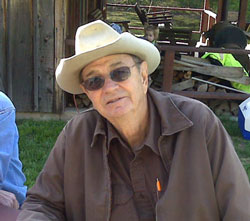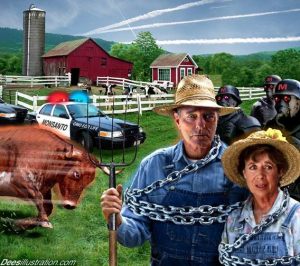NATURAL SOLUTIONS FOUNDATION
Your Global Voice of Health & Food Freedom™
www.HealthFreedomPortal.org
<blockquote>Health Freedom USA is pleased to re-post this article by Ms. Hannes which was originally circulated by our friends at NAIS Stinks.com … NAIS is the National Animal Identification System which wants to “chip” all farm animals, “voluntarily” — and, for many reasons we agree with them, NAIS stinks! Both Codex and S.510 are very NAIS friendly, and thus not friendly to farmers, consumer or environment – see: www.FriendlyFoodCertification.org.</blockquote>
Why S.510 Does NOT Protect Local, Natural Food… or Freedom!
S. 510 Hits A Snag
by: Doreen Hannes Dec. 4, 2010
Reprinted with permission from www.naisstinks.com
Senate Bill S 510, the Food Safety Modernization Act, passed the Senate on November 30th, 74-23. Not a single Democrat crossed party lines. This bill is the coup on food in the US. Even though the Tester Amendment was included to dupe those who think it will stop small farmers and processors from being put right out of business, it will only slow down the demise of some small farms.
Then it came to light that a Constitutional issue that had been staring all of us in the face was present. The Senate did not pick up HR2749, which passed the House in July of 2009; instead they took up their own monster in S 510. They also began revenue generation in the Senate (Section 107 of the bill), which is expressly forbidden by the Constitution.
Faced with a patently un-Constitutional bill, that violates Constitutional process, we have to remain vigilant until BOTH houses have adjourned for the winter recess prior to the next session of Congress. Talk about roller coasters.
If the Constitution means anything at all, the House should blue slip S. 510, which would preclude them from taking the bill up and very likely run out the clock for passage in this session.
However, there are four choices available for the legislation to move forward before they adjourn on December 24th. The first is for the Senate to bring it back and get unanimous consent to remove the offending section. Since Senator Coburn of Oklahoma will not consent, that avenue is cut off.
Second is for the Senate to bust S. 510 down to the original a compromise amendment, remove the funding section and the Tester amendment and try to ram it through the entire senate process again before the 24th. This seems unlikely, but do not trust them as far as you can throw a semi trailer loaded with lead.
Third, the Senate could take HR2749, which has already passed the House, and rush it through the Senate, and it would go straight to the Presidents desk with no process with the House necessary. This also seems rather unlikely. The bills are very similar and would have the same detrimental effects for everyone, but the Senators are not familiar with the bill, so it could be really tough.
Fourth, the House Ways and Means committee could pass the bill through and forgive the Constitutional infraction and refuse to blue slip the bill, then vote on it before the 24th and we would have the bill albeit there would be legal issues brought forth that could possibly ensnare the regulations they want to write under this bill. This appears to be the most likely potential for S. 510.
Make no mistake about this, SB 510, or HR 2749 are worse than the Patriot Act, the Health Care bill, and the Federal Reserve Act combined. We can all live without little pieces of paper, and many of us can live without doctors, and we have been living with the increasing police state since 911, but none of us can live without food and water. If we lose food and water, we will not be able to fight anything else.
The Tester-Hagan Amendment Lipstick on a Pig
The largest deception played on the public in S. 510 is the inclusion of the Tester Amendment. This amendment was sold as the complete exemption for all small farms grossing less than $500,000 per year. But if one reads the actual amendment, it is evident that it will not do what it is purported to do for the vast majority of small producers.
The Tester Amendment has strident restrictions on those who may be exempted from HACCP (Hazard and Critical Control Point) implementations. HACCP is 50 pages of instructions that require a certifier to sign off on the plan, and a team to be trained in ensuring the plan is followed on the farm. The requirement of this plan put about 40% of small meat processors out of business several years ago. If you fall under the protection of the Tester amendment, you will not have to do it….but let us see how protective the Tester Amendment really is.
First, the Tester Amendment purports to exempt farms with less than $500,000 in sales from the requirements of S.510. However, to be exempt one must sell more than 50% of their products directly to consumers or restaurants within a 275-mile radius from production, and keep records substantiating those sales. The records are open for inspection and verification of the exemption. In other words, you have to prove you are playing by their rules through record keeping and approval of those records, or meet the more onerous requirements of S.510.
You must apply to be included in the protections of the Tester amendment. You must substantiate through your records for three years that you fit the category of selling more than 50% of average annual monetary value within this 275-mile radius. So, if you sell on the roadside or at a farmers market, you must have a map handy and ask for ID from everyone who purchases from you or lose your exemption. Nice, huh?
Proof of Residence for Food? Really?
I can see it now….A lovely early June day, with the birds singing and the smell of freshly mown hay hanging in the air like the best memory from childhood. A young mother pulls into the Farmers Market and readies herself for a wonderful shopping experience.
She approaches the first stand with her mouth nearly watering at the bright display of fresh produce. I would like 3 cucumbers, please, says the lady with her 3 kids and cloth grocery bag.
Great! Can I see your ID? replies the guy in bibs.
Oh, I am paying with cash she replies with a smile.
No matter, says the farmer, We have to make sure you are within a 275 mile radius of our farm in order to sell to you.
She looks perplexed and says, Well, we are not. We are on our way to visit my parents and I wanted to make a special dinner for all of us, using their locally produced foods so they could remember how good home grown veggies are….So I can not buy from you without an ID?
The farmer scratches his head and says, Now see, I have to be very careful. I belong to a CSA that sells to a Chipotle that is 276 miles from us, so all of my sales at market have to be local or I lose my exemption and will have to hire 5 people to take care of the paper work and then I just go out of business. So no, I can not sell to you. What is more, all the vendors here are part of the CSA, so no one here can sell to you. You have a nice day now!
No Surprises-It is Locally — Global
What we have in Tester is local Agenda 21 Sustainable Development. In sum, control over all human impact on the environment. Everything will need to be within the food shed, and if you are outside of the food shed, too bad for you. It is a great way to surveille and monitor food production and distribution. And you still fall under the broad based reason to believe of the Secretary with the Tester amendment. If the Secretary, meaning the head of the FDA or HHS thinks you may have a problem, or deems what you produce to be high risk, you will be shut down until they say you can begin again. All of your product is subject to mandatory recall; that is why you have to keep records of everyone you sell to. And you will have to register as a facility under the Bioterrorism Act of 2002, referred to as Sec 415 throughout the bill. (Knock knock—this is premises identification as in NAIS)
So please, do not tell me how great the Tester Amendment is, and that the expansive powers being granted to the DoD, DHS, HHS, FDA and USDA in this bill will be helpful to small farmers and local food production and make my food safe. Wake up and smell the coffee!!! Oh, wait. The only state that could produce coffee within 275 miles of itself, is Hawaii. Never mind. Wake up, and smell the tyranny, please.
(The best thing to do right now is to call the members of the House Ways and Means Committee as well as your own Representative and tell them they MUST blue slip S. 510. While I know it gets frustrating to call the Congress critters, the more they know that we know, the better the chance at slowing down the destruction they have planned for us. The switchboard number for Congress is 202-224-3121.)

 The Left is notorious for their friendly-sounding nomenclature of bills. The American Recovery and Reinvestment Act was the phony stimulus bill; the Patient Protection and Affordable Care Act is Obamacare; Wall Street Reform and Consumer Protection Act is Wall Street regulation. Each of these monstrosities have the same thing in common: they do the exact opposite as they’re advertised. And that’s why S-510, the Food Safety Modernization Act needs to be stopped from turning into law. It goes to the Senate floor for a vote the day after Thanksgiving.
The Left is notorious for their friendly-sounding nomenclature of bills. The American Recovery and Reinvestment Act was the phony stimulus bill; the Patient Protection and Affordable Care Act is Obamacare; Wall Street Reform and Consumer Protection Act is Wall Street regulation. Each of these monstrosities have the same thing in common: they do the exact opposite as they’re advertised. And that’s why S-510, the Food Safety Modernization Act needs to be stopped from turning into law. It goes to the Senate floor for a vote the day after Thanksgiving.
 In December, some Missouri sale-barns began using the NAIS tags. The barn owners said they had been instructed by the Missouri Department of Agriculture to apply these “840” tags to every cow unloaded at the sale barn. After showing them the law prohibiting the state from doing what they had enticed the barn owners to do, a hearing was held in the State Capital to see if the State Veterinarian was abiding by Missouri law. The Missouri State Veterinarian, Taylor Woods, testified that they had no official written policy on the use of the “840” tags. The state officials had no jurisdiction over the barn owners and was pushing the United Nation’s agenda through intimidation.
In December, some Missouri sale-barns began using the NAIS tags. The barn owners said they had been instructed by the Missouri Department of Agriculture to apply these “840” tags to every cow unloaded at the sale barn. After showing them the law prohibiting the state from doing what they had enticed the barn owners to do, a hearing was held in the State Capital to see if the State Veterinarian was abiding by Missouri law. The Missouri State Veterinarian, Taylor Woods, testified that they had no official written policy on the use of the “840” tags. The state officials had no jurisdiction over the barn owners and was pushing the United Nation’s agenda through intimidation.
 By Doreen Hannes
By Doreen Hannes






 The costs and time needed to comply with program requirements would give the largest operations a competitive advantage. This further promotes an unhealthy control of the meat market among a handful of corporations. Ironically, large-scale operators use confinement methods and feeding practices that are viewed by many as increasing the risk of animal diseases that NAIS would track.
The costs and time needed to comply with program requirements would give the largest operations a competitive advantage. This further promotes an unhealthy control of the meat market among a handful of corporations. Ironically, large-scale operators use confinement methods and feeding practices that are viewed by many as increasing the risk of animal diseases that NAIS would track.
 The vice president of Agri Beef is Rick Stott,
The vice president of Agri Beef is Rick Stott, And because RFID devices are sold by privately owned companies, the USDA’s multi-million dollar “840 Start Up” campaign may really serve to funnel millions of dollars into the bank accounts of the few tech companies that have been approved to sell these products.
And because RFID devices are sold by privately owned companies, the USDA’s multi-million dollar “840 Start Up” campaign may really serve to funnel millions of dollars into the bank accounts of the few tech companies that have been approved to sell these products. The state of Michigan has gone a step farther than Wisconsin, issuing a requirement that every head of cattle in the state must now have an RFID tag, essentially creating a state-wide mandatory animal-tracking system.
The state of Michigan has gone a step farther than Wisconsin, issuing a requirement that every head of cattle in the state must now have an RFID tag, essentially creating a state-wide mandatory animal-tracking system.
 104 Several places on the Web site such as “Order Bovine Eartags” direct you to Holstein USA, although in late spring 2009 some portions of the website did add Northstar Cooperative to the page. However, if you download a PDF entitled “Mandatory Cattle Identification Program Q & A,” the question-and-answer number-23 informs you that you can also order RFID tags from Northstar Cooperative.
104 Several places on the Web site such as “Order Bovine Eartags” direct you to Holstein USA, although in late spring 2009 some portions of the website did add Northstar Cooperative to the page. However, if you download a PDF entitled “Mandatory Cattle Identification Program Q & A,” the question-and-answer number-23 informs you that you can also order RFID tags from Northstar Cooperative. As you may know the US government is trying to pass a law, HR2749, which is about imposing totalitarian control on the food supply (such as mandating GMO-food) and restricting anything natural or healthy, such as access to supplements or even any natural food. Our health and very lives and the lives of our children depend on this being stopped. This is not an exaggeration. Our food supply will be placed in the hands of large factory farms and conglomerates like Monsanto who’s only objective is profits.
As you may know the US government is trying to pass a law, HR2749, which is about imposing totalitarian control on the food supply (such as mandating GMO-food) and restricting anything natural or healthy, such as access to supplements or even any natural food. Our health and very lives and the lives of our children depend on this being stopped. This is not an exaggeration. Our food supply will be placed in the hands of large factory farms and conglomerates like Monsanto who’s only objective is profits.